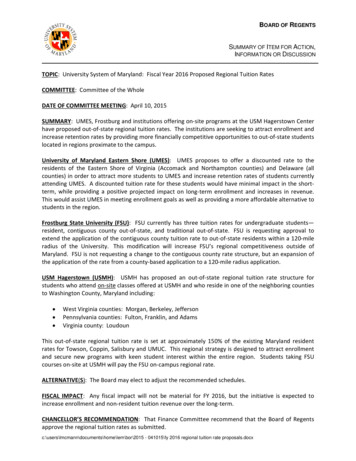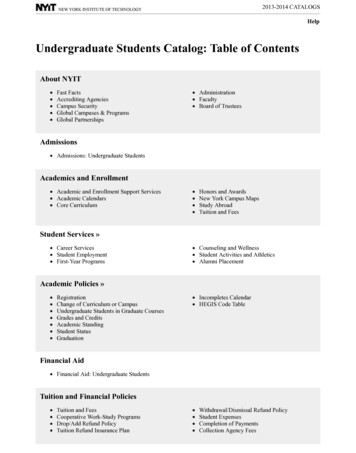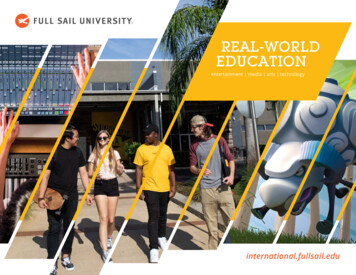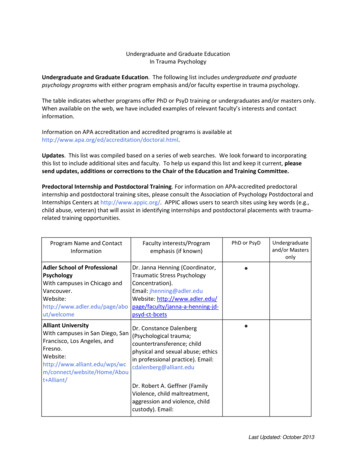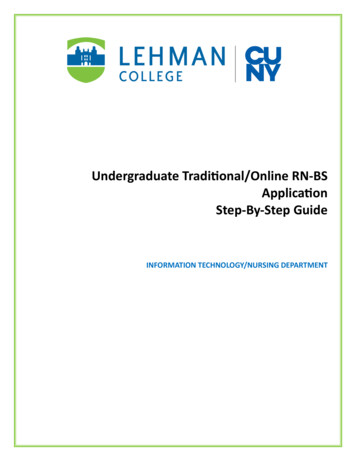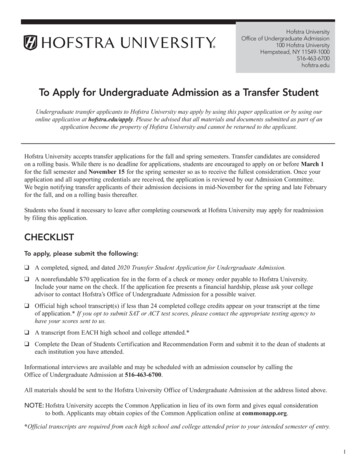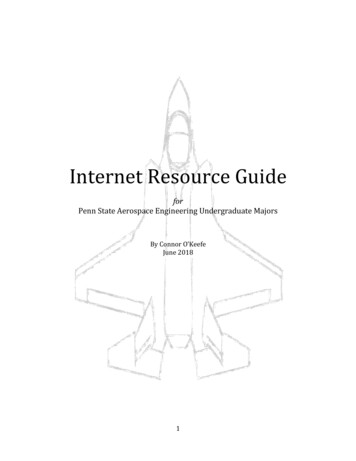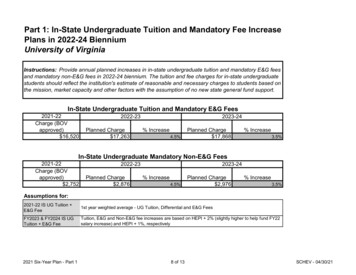
Transcription
Part 1: In-State Undergraduate Tuition and Mandatory Fee IncreasePlans in 2022-24 BienniumUniversity of VirginiaInstructions: Provide annual planned increases in in-state undergraduate tuition and mandatory E&G feesand mandatory non-E&G fees in 2022-24 biennium. The tuition and fee charges for in-state undergraduatestudents should reflect the institution's estimate of reasonable and necessary charges to students based onthe mission, market capacity and other factors with the assumption of no new state general fund support.In-State Undergraduate Tuition and Mandatory E&G Fees2021-22Charge (BOVapproved) 16,5202022-23Planned Charge 17,2632023-24% Increase4.5%Planned Charge 17,868% Increase3.5%In-State Undergraduate Mandatory Non-E&G Fees2021-22Charge (BOVapproved) 2,7522022-23Planned Charge 2,8762023-24% Increase4.5%Planned Charge 2,976% Increase3.5%Assumptions for:2021-22 IS UG Tuition E&G Fee1st year weighted average - UG Tuition, Differential and E&G FeesFY2023 & FY2024 IS UGTuition E&G FeeTuition, E&G and Non-E&G fee increases are based on HEPI 2% (slightly higher to help fund FY22salary increase) and HEPI 1%, respectively2021 Six-Year Plan - Part 18 of 13SCHEV - 04/30/21
Part 2: Tuition and Other Nongeneral Fund (NGF) RevenueUniversity of VirginiaInstructions: Based on assumptions of no new general fund, enrollment changes and other institution-specificconditions, provide total collected or projected to collect revenues (after discounts and waivers) by student leveland domicile (including tuition revenue used for financial aid), and other NGF revenue for educational and general(E&G) programs; and mandatory non-E&G fee revenues from in-state undergraduates and other students as wellas the total auxiliary revenue. DO NOT INCLUDE STIMULUS FUNDS.ItemsE&G ProgramsUndergraduate, In-StateUndergraduate, Out-of-StateGraduate, In-StateGraduate, Out-of-StateLaw, In-StateLaw, Out-of-StateMedicine, In-StateMedicine, Out-of-StateDentistry, In-StateDentistry, Out-of-StatePharmD, In-StatePharmD, Out-of-StateVeterinary Medicine, In-StateVeterinary Medicine, Out-of-StateOther NGFTotal E&G RevenueNon-E&G Fee RevenueIn-State undergraduatesAll Other studentsTotal non-E&G fee revenueTotal Auxiliary Revenue2021 Six-Year Plan - Part 12020-2021 (Actual)2021-2022 (Estimated) 2022-2023 (Planned)2023-2024 (Planned)Total Collected Tuition Total Collected Tuition Total Projected Tuition Total Projected TuitionRevenueRevenueRevenueRevenue 173,289,000 266,324,000 49,921,000 114,884,000 13,677,000 47,086,000 15,375,000 21,850,000 0 0 0 0 0 0 33,893,000 736,299,000 200,317,000 261,918,000 53,507,000 119,205,000 15,679,000 46,887,000 14,939,000 22,986,000 0 0 0 0 0 0 49,292,000 784,730,000 209,331,000 273,704,000 55,915,000 124,569,000 16,385,000 48,997,000 15,611,000 24,020,000 0 0 0 0 0 0 51,362,000 819,894,000 216,658,000 283,284,000 57,872,000 128,929,000 16,958,000 50,712,000 16,157,000 24,861,000 0 0 0 0 0 0 53,006,000 848,437,0002020-2021 (Actual)2021-2022 (Estimated) 2022-2023 (Planned)2023-2024 (Planned)Total Tuition Revenue Total Tuition Revenue Total Tuition Revenue Total Tuition Revenue 26,831,000 30,469,000 57,300,000 148,275,000 27,776,000 31,542,000 59,318,000 192,584,0009 of 13 28,943,000 32,867,000 61,810,000 200,673,000 29,869,000 33,919,000 63,788,000 207,095,000SCHEV - 04/30/21
Part 3: ACADEMIC-FINANCIAL PLANUniversity of Virginia3A: Six-Year Plan for Academic and Support Service Strategies for Six-year Period (2022-2028)Instructions for 3A: The Academic Plan should contain academic, finance, and support service strategies the institution intends to employ in meeting state needs/goals as found in the Virginia Plan. (Please see the main instructions sheet in this workbook for more detailed informationabout The Virginia Plan. Please provide short titles to identify institutional strategies. Provide a concise description of the strategy in the Description of Strategy column (column J). Within this column, provide a specific reference as to where more detailed information can be found in theNarrative document. Note the goal(s) with which the strategy is aligned with the Virginia Plan (in particular, the related priority areas) in the VP Goal column and give it a Priority Ranking in column A. Additional information for 2024-2028 should be provided in column K (Two AdditionalBiennia). Strategies for student financial aid, other than those that are provided through tuition revenue, should not be included on this table; they should be included in Part 4, General Fund Request, of the plan. All salary information must be provided in section 3B. No salaryinformation should be included in 3A. Funding amounts in the first year should be incremental. However, if the costs continue into the second year, they should be reflected cumulatively. Please update total cost formulas if necessary. Institutions should assume no generalfund (GF) support in this worksheet. A separate worksheet (Part 4) is provided for institutions to request GF support. IF ANY STRATEGIES WILL BE FUNDED WITH STIMULUS FUNDS, PLEASE INCLUDE THOSE FUNDS IN THE REALLOCATION COLUMNS.ACADEMIC AND SUPPORT SERVICE STRATEGIES FOR SIX-YEAR PERIOD (2022-2028)Biennium 2022-2024 (7/1/22-6/30/24)PriorityRanking1234567Strategies (Short Title)SuccessUVAThird-Century Faculty InitiativePathways to Research PreeminenceOpen Grounds at Emmet-IvyBroadening our HorizonsBachelor’s Completion & Certificate ProgramsCitizen-Leaders for the 21st CenturyTotal 2022-2024 Costs (Included in Financial Plan 'TotalAdditional Funding Need')2021 Six-Year Plan - Part 1VPGoal1,21,2,3331,2,31,2,31,2,32022-2023Total Amount 0 6,854,000 0 0 3,000,000 2,100,000Reallocation 0 0 0 0 2,000,000 02023-2024Amount FromTuition Revenue 0 6,854,000 0 0 1,000,000 2,100,000Total Amount 0 5,440,000 0 0 3,000,000 4,300,000ReallocationAmount FromTuition Revenue 0 0 0 2,000,000 0 0 0 0 0 11,954,000 2,000,000 9,954,000 12,740,000 2,000,000Two Additional BienniaConcise Information for Each StrategyInformation for 2024- 2028Expand efforts to attract more first-generation andunder-represented students and provide them with theresources and support that they need. Funding to be 0provided by other institutional resources. (additionaldetails available on page 4 of the narrative) 0 0Description of StrategyExpand efforts to attract more first-generation andunder-represented students and provide them with theresources and support that they need.Invest in innovative hiring programs to recruit the verybest researchers, teachers, and mentors. Additional 5,440,000 funding will be necessary and will be provided by otherinstitutional resources. (additional details available onpage 4 of the narrative)Invest in research infrastructure; focus on pressingissues that will allow UVA to be an international leaderin research; and provide funding to launch and grow 0research initiatives. Funding to be provided by otherinstitutional resources. (additional details available onpage 4 of the narrative)Encourage cross-disciplinary endeavors involvingpeople from across grounds and beyond, in an activeand engaging environment on the 14-acre site at theEmmet-Ivy site to enhance our community and 0 encourage cross-disciplinary discoveries. Funding to beprovided by other institutional resources. (additionaldetails available on page 3 of the narrative)Invest in innovative hiring programs to recruit the verybest researchers, teachers, and mentors.Increase our impact in Northern Virginia by growing ourresearch footprint, reaching more students, anddeveloping new partnerships, including those focusedon workforce development. Partner with the College at 1,000,000 Wise to support economic development in SouthwestVirginia. Additional funding to be provided by otherinstitutional resources. (additional details available onpage 5 of the narrative)Increase our impact in Northern Virginia by growing ourresearch footprint, reaching more students, anddeveloping new partnerships, including those focusedon workforce development. Partner with the College atWise to support economic development in SouthwestVirginia.Expand degree-completion opportunities and otherofferings for skill development. Additional funding may 4,300,000 be necessary and will be provided by other institutionalresources. (additional details available on page 5 of thenarrative)Prepare students to be productive servant-leaders in adiverse, globally connected world, regardless of their 0 careers or professions. Funding to be provided by otherinstitutional resources. (additional details available onpage 5 of the narrative)Expand degree-completion opportunities and otherofferings for skill development.Invest in research infrastructure; focus on pressingissues that will allow UVA to be an international leaderin research; and provide funding to launch and growresearch initiatives.Encourage cross-disciplinary endeavors involvingpeople from across grounds and beyond, in an activeand engaging environment on the 14-acre site at theEmmet-Ivy site to enhance our community andencourage cross-disciplinary discoveries.Prepare students to be productive servant-leaders in adiverse, globally connected world, regardless of theircareers or professions. 10,740,00010 of 13SCHEV - 04/30/21
Part 3: ACADEMIC-FINANCIAL PLANUniversity of Virginia3B: Six-Year Financial Plan for Educational and General Programs, Incremental Operating Budget Need 2022-2024 BienniumInstructions for 3B: Complete the lines appropriate to your institution. As completely as possible, the items in the Academic Plan (3A) and Financial Plan (3B) should represent a complete picture of the institution's anticipated use of projected tuition revenues. For every strategy in 3A andevery item in 3B of the plan, the total amount and the sum of the reallocation and tuition revenue should equal one another. Two additional rows, "Anticipated Nongeneral Fund Carryover" and "Nongeneral Fund Revenue for Current Operations" are available for an institution's use, if aninstitution cannot allocated all of its tuition revenue to specific strategies in the plan. Also, given the long standing practice that agencies should not assume general fund support for operation and maintenance (O&M) of new facilities, O&M strategies should not be included in aninstitution's plan, unless they are completely supported by tuition revenue. Please do not add additional rows to 3B without first contacting Jean Huskey. All salary information should be included in this section. No salary information should be included in 3A.2022-2023Assuming No Additional General FundTotal AmountItemsTotal Incremental Cost from Academic Plan1Increase T&R Faculty Salaries ( )T&R Faculty Salary Increase Rate(%)2 11,954,000 2,000,000 8,877,000 03.00%Increase Admin. Faculty Salaries ( )Admin. Faculty Salary Increase Rate (%) 1,316,0002 020.00% 13,822,000Increase University Staff Salaries ( )University Staff Salary Increase Rate (%) 03.00%Increase Classified Staff Salaries ( )Classified Salary Increase Rate (%)Reallocation2 0 03.00%32023-2024Amount FromTuition RevenueTotal AmountReallocationAmount FromTuition Revenue 9,954,000 12,740,000 2,000,000 10,740,000 8,877,000 18,021,000 0 18,021,0003.00%3.00% 1,316,000 2,671,000 0 2,671,0003.00%3.00% 0 00.00%0.00% 13,822,000 28,058,0003.00%3.00% 0 0 3,610,0003.00%3.00% 0 00.00% 0 28,058,0003.00% 0 0 0 0 1,183,000 0 1,183,000 3,610,000 0Addt'l In-State Student Financial Aid from Tuition Rev 5,099,000 0 5,099,000 9,401,000 0 9,401,000Addt'l Out-of-State Student Financial Aid from Tuition Rev 8,643,000 0 15,870,000 0Anticipated Nongeneral Fund Carryover 8,643,000 15,870,000 0 0 0 0 0Nongeneral Fund for Current Operations (Safety & Security; Fringe B 0 0 0 0 0 0 0 247,000 0 247,000 501,000 0 501,000 3,230,000 0 0 2,000,000 3,230,000 52,371,000 5,190,000 54,371,000 96,062,000 2,000,000 5,190,000 94,062,000Increase Number of Full-Time T&R Faculty( )O&M for New FacilitiesLibrary EnhancementUtility Cost IncreaseTotal Additional Funding NeedNotes:(1) Please ensure that these items are not double counted if they are already included in the incremental cost of the academic plan.(2) If planned, enter the cost of any institution-wide increase.(3) If planned, enter the cost of additional FTE faculty.Auto Check (Match 0)Match Incremental Tuit Rev in Part 2If not matched, please provide explanation in these fields.2022-20232023-20242022-20232023-2024- 17,207,000- 30,355,000 Driven by increased costs associated with theDriven by increased costs associated with theUniversity’s strategic priorities listed above (andUniversity’s strategic priorities listed above (anddetailed in the narrative), FY2022 salary increases, detailed in the narrative), the ongoing impact of thesalary increases implemented in FY2022, O&M forO&M for new facilities, utility rate increases, andnew facilities, utility rate increases, and financialfinancial aid. A portion of the FY2022 salaryaid. Private funds/other sources will be used toincrease will be covered by the additional 1%cover any shortfall.tuition increase in FY2023. Private funds/othersources will be used to cover any shortfall.2021 Six-Year Plan - Part 111 of 13SCHEV - 04/30/21
Part 4: General Fund (GF) RequestUniversity of VirginiaInstructions: Indicate items for which you anticipate making a request for state general fund in the 2022-24 biennium. The item can be a supplement to a strategy or item from theacademic and financial plan or it can be a free-standing request for which no tuition revenue would be used. If it is a supplement to a strategy or item from the academic and financial plan,use the same title used in Part 3 and place it in bold print to draw attention to it's connection to Part 3. Also, describe in the Notes column how additional general fund will enhance orexpand the strategy. Requests for need-based financial aid appropriated in program 108 should be included here. If additional rows are added, please update the total costs formulas.Initiatives Requiring General Fund SupportBiennium 2022-2024 (7/1/22-6/30/24)PriorityRanking1Strategies (Match Academic-FinancialWorksheet Short Title)Maintain Affordable AccessVPGoal22022-2023Total Amount 3,501,500Notes2023-2024GF Support 3,501,500Total AmountGF Support 3,501,500Makes permanent the one-time GF allocation toaddress affordability issues due to unavoidable cost 3,501,500 increases and required expenses; additional detailsavailable on page 8 of the narrative2Minimum Wage Increases for Work Study Students3Public Service Loan Forgiveness Pilot Program4Cancer Research Funding5FY21 COVID Direct Expense Recovery6Health Insurance Premiums78 33,061 22,151 55,000 37,148 Additional details available on page 8 of the narrative1,2,3 11,000,000 5,500,000 0 0 Additional details available on page 8 of the narrative3 11,000,000 11,000,000 11,000,000 11,000,000 Additional details available on page 8 of the narrative1,2,3 42,737,253 21,127,974 0 0 Additional details available on page 8 of the narrative2 2,400,000 840,000 6,500,000 2,270,000 Additional details available on page 8 of the narrativeO&M for New Facilities2 1,183,000 304,000 3,610,000 927,000 Additional details available on page 8 of the narrativeUtilities2 3,230,000 830,000 5,190,000 1,333,000 Additional details available on page 8 of the narrative 75,084,814 43,125,625 29,856,5002021 Six-Year Plan - Part 12,312 of 13 19,068,648SCHEV - 04/30/21
Part 5: Financial Aid PlanUniversity of VirginiaInstructions: Provide a breakdown of the projected source and distribution of tuition and fee revenue redirected to financial aid. To ensure compliance with the stateprohibition that in-state students not subsidize out-of-state students and to provide the review group with a scope of the strategy, projections must be made for each ofthe indicated categories. Please be aware that this data will be compared with similar data provided by other institutional offices in order to ensure overall consistency.(Please do not alter shaded cells that contain formulas.)" Other Discounts and Waiver " means the totals of any unfunded full or partial tuition waiver reducing the students' charges, including Virginia Military Survivors andDependent Education Program and the Senior Citizens Tuition Waiver. Do not include the tuition differential for the tuition exceptions.Note: If you do not have actual amounts for Tuition Revenue for Financial Aid by student category, please provide an estimate. If values are notdistributed for Tuition Revenue for Financial Aid , a distribution may be calculated for your institution.Allocation of Tuition Revenue Used for Student Financial Aid*2020-21 (Actual) Please see footnote belowT&F Used for Financial AidUndergraduate, In-StateUndergraduate, Out-of-StateGraduate, In-StateGraduate, Out-of-StateFirst Professional, In-StateFirst Professional, Out-of-StateTotalT&F Used for Financial AidUndergraduate, In-StateUndergraduate, Out-of-StateGraduate, In-StateGraduate, Out-of-StateFirst Professional, In-StateFirst Professional, Out-of-StateTotalT&F Used for Financial AidUndergraduate, In-StateUndergraduate, Out-of-StateGraduate, In-StateGraduate, Out-of-StateFirst Professional, In-StateFirst Professional, Out-of-StateTotalT&F Used for Financial AidUndergraduate, In-StateUndergraduate, Out-of-StateGraduate, In-StateGraduate, Out-of-StateFirst Professional, In-StateFirst Professional, Out-of-StateTotalTotal TuitionRevenue 173,289,000 266,324,000 49,921,000 114,884,000 29,052,000 68,936,000 702,406,000Total TuitionRevenue 200,317,000 261,918,000 53,507,000 119,205,000 30,618,000 69,873,000 735,438,000Total TuitionRevenue 209,331,000 273,704,000 55,915,000 124,569,000 31,996,000 73,017,000 768,532,000Total TuitionRevenue 216,658,000 283,284,000 57,872,000 128,929,000 33,115,000 75,573,000 795,431,000TuitionOther Tuition Gross TuitionRevenue for% Revenue for Distribution ofUnfundedDiscountsRevenue (Cols.Financial AidFinancial Aid ScholarshipsFinancial Aidand WaiversB F G)(Program 108)22.4% 38,814,000 38,814,000 0 10,093,000 183,382,000 53,336,00020.0% 53,336,000 0 14,243,000 280,567,000 7,549,00015.1% 7,549,000 0 1,676,000 51,597,000 0 180,000 115,064,00042.8% 49,224,000 49,224,0007.8% 2,257,000 0 200,000 29,252,000 2,257,00013.4% 9,225,000 9,225,000 0 69,000 69,005,00022.8% 160,405,000 160,405,000 0 26,461,000 728,867,0002021-22 (Estimated)TuitionOther Tuition Gross TuitionRevenue for% Revenue for Distribution ofUnfundedDiscountsRevenue (Cols.Financial AidFinancial Aid ScholarshipsFinancial Aidand WaiversB F G)(Program 108) 43,147,00021.5% 43,147,000 0 883,000 201,200,000 55,054,00021.0% 55,054,000 0 2,000 261,920,000 0 1,539,000 55,046,000 7,839,00014.7% 7,839,000 50,965,00042.8% 50,965,000 0 121,000 119,326,000 2,345,0007.7% 2,345,000 0 0 30,618,000 9,552,00013.7% 9,552,000 0 0 69,873,00023.0% 168,902,000 168,902,000 0 2,545,000 737,983,0002022-23 (Planned)TuitionOther Tuition Gross TuitionRevenue for% Revenue for Distribution ofUnfundedRevenue (Cols.DiscountsFinancial AidFinancial Aid ScholarshipsFinancial AidB F G)and Waivers(Program 108)22.8% 47,787,000 47,787,000 0 923,000 210,254,000 0 2,000 273,706,000 60,974,00022.3% 60,974,000 8,192,00014.7% 8,192,000 0 1,608,000 57,523,000 53,258,00042.8% 53,258,000 0 126,000 124,695,000 2,451,0007.7% 2,451,000 0 0 31,996,000 9,982,00013.7% 9,982,000 0 0 73,017,00023.8% 182,644,000 182,644,000 0 2,659,000 771,191,0002023-24 (Planned)TuitionOther Tuition Gross TuitionRevenue for% Revenue for Distribution ofUnfundedDiscountsRevenue (Cols.Financial AidFinancial Aid ScholarshipsFinancial Aidand WaiversB F G)(Program 108) 51,716,00023.9% 51,716,000 0 955,000 217,613,000 0 2,000 283,286,000 65,988,00023.3% 65,988,000 8,479,00014.7% 8,479,000 0 1,664,000 59,536,000 0 130,000 129,059,000 55,122,00042.8% 55,122,000 2,537,0007.7% 2,537,000 0 0 33,115,000 10,331,00013.7% 10,331,000 0 0 75,573,000 194,173,00024.4% 194,173,000 0 2,751,000 798,182,000Compliancewith § 4-5.1.a.i 0 CompliantCompliancewith § 4-5.1.a.i 0 CompliantCompliancewith § 4-5.1.a.i 0 CompliantCompliancewith § 4-5.1.a.i 0 Compliant* Please note that the totals reported here will be compared with those reported by the financial aid office on the institution's annual S1/S2 report. Since the six-yearplan is estimated and the S1/S2 is “actual,” the numbers do not have to match perfectly but these totals should reconcile to within a reasonable tolerance level. Pleasebe sure that all institutional offices reporting tuition/fee revenue used for aid have the same understanding of what is to be reported for this category of aid.2021 Six-Year Plan - Part 1Page 13 of 13SCHEV - 04/30/21
2021 SIX-YEAR PLAN NARRATIVE (Part II)INSTITUTION: UNIVERSITY OF VIRGINIAOVERVIEWThe totality of the six-year plan should describe the institution’s goals as they relate to state goals found inthe Pathways to Opportunity: The Virginia Plan for Higher Education; the Higher Education Opportunity Actof 2011 (TJ21); and the Restructured Higher Education Financial and Administrative Operations Act of2005.The instructions under institutional mission and alignment to state goals, below, ask for specific strategies,in particular related to equity, affordability and transformative outcomes. Other sections will offer institutionsthe opportunity to describe additional strategies to advance institutional goals and state needs. Please beas concise as possible with responses and save this narrative document with your institution’sname added to the file name.SECTIONSSection A. Pandemic Impact: Briefly discuss, in one to two paragraphs, how the pandemic has impactedyour institution. What things did your institution already have in place that proved helpful? What lessonswere learned? What short-term changes have been made? What long-term changes will be made? Whatare the concerns moving forward?RESPONSE:In March 2020, the University of Virginia (UVA) shifted to remote work for many employees and a virtuallearning environment in a matter of days. In support of this immediate shift and over the past year, facultyhave engaged in various activities and implemented practices to deliver the best educational experiencepossible to our students including, but certainly not limited to, developing resources to provide support –both pedagogical and technological – needed for remote teaching (teachingcontinuity.virginia.edu);expanding learning technologies to provide new tools and improve student engagement; redesigningcourses using the Center for Teaching Excellence’s c3Design program; creating workshops and othervehicles for faculty to work together and share ideas about learning technologies and student engagement;and shifting various arts programs to online forums, allowing them to reach much larger audiences (e.g.,Virginia Film Festival; Fralin Museum online programming for K-12 students; “Arts on the Hill” series thatshared student art with the University community; virtual recitals, drama, dance, musical performances, andartists talks and panels; etc.)UVA also offered free online J-term (January term) and 1st summer session courses, and created a set ofsignature courses which were largely cross-disciplinary and taught by faculty members from across theUniversity. UVA remains committed to its strong residential student experience, while also continuing toexplore opportunities to augment this experience. To that end, we are evaluating continuing a set of coursesonline in J-term and in summer session when many students may want to engage in online/virtual coursesthat will allow them to accumulate course credit and make additional progress toward their degree whileliving at home or engaged in summer employment or internships.With study abroad programs evacuated in Spring 2020 and closed through May 2021, UVA providedstudents with alternative international experiences through several new initiatives largely based on virtualtechnology including the Global Mentors Program; Virtual Summer Language Institute; virtual globalinternships; innovative new global research opportunities pairing UVA students and faculty withinternational partners across the globe; translation of public health guidance into 30 foreign languages by275 student volunteers for the University’s and Charlottesville’s international community; and various1
globally-themed programming including more than 20 virtual and actual visits by U.S. and internationalAmbassadors in the last two years.We anticipate that many of the innovations we pioneered to maintain global engagement during thepandemic – including virtual global mentors, virtual global internships, and virtual global health researchpartnerships – will remain a permanent feature of our global program, allowing an even greater number ofour students to have a global experience at a lesser cost.The University’s plans to return to in-person learning and living for students will mean that many UVAemployees who have been working remotely will return to working in person this summer and fall. Ouradaption to new ways of working during the pandemic has taught us valuable lessons about how tocreatively approach our work in the future. To that end, a group of experts from around the University isdeveloping recommendations about the future of work at the University. Their recommendations areexpected this summer, and schools and units will continue to develop and refine their return-to-Groundsplans in the coming months. Individual schools or operating units will continue to have the authority to workwith employees to structure flexible work arrangements (including alternative work schedules andlocations), in keeping with the management needs of the school or the unit.More flexible work arrangements and remote work will enable us to closely examine the use of our space,particularly external leases. We already know of one large administrative unit that has developed a hotelingplan that has allowed them to consolidate their personnel within a single building and terminate a lease ofapproximately 20,000 square feet, saving in excess of 700,000 annually. Fewer employees physically onGrounds also has implications for parking requirements, likely lessening the need for new parking structuresboth in the short and long term.One of the most significant ongoing concerns relates to pandemic-related expenses. We currently projectunrecovered expenses of over 23 million in FY2021 and 15.3 million in FY2022; and lost auxiliaryrevenues of nearly 35 million in FY2021 and more than 27 million in FY2022. Without additional federalstimulus funding, the University will need to allocate more than 100 million in reserves or other institutionalresources to cover these additional costs and revenue losses.2
Section B. Institutional Mission, Vision, Goals, Strategies, and Alignment to State Goals: Provide astatement of institutional mission and indicate if there are plans to change the mission over the six-yearperiod.Provide a brief description of your institutional vision and goals over the next six years, including numerictargets where appropriate. Include specific strategies (from Part 3 – Academic-Financial Plan and Part 4 –General Fund Request) related to the following state themes and goals: Equitable: Close access and completion gaps. Remove barriers to access and attainmentespecially for Black, Hispanic, Native American and rural students; students learning English as asecond language; students from economically disadvantaged backgrounds; and students withdisabilities. Affordable: Lower costs to students. Invest in and support the development of initiatives thatprovide cost savings to students while maintaining the effectiveness of instruction. Transformative: Expand prosperity. Increase the social, cultural and economic well-being ofindividuals and communities within the Commonwealth and its regions. This goal includes effortsto diversify staff and faculty pools.Strategies also can cross several state goals, notably those related to improved two-year and four-yeartransfer, and should be included here. If applicable, include a short summary of strategies related toresearch. The description of any strategy should be one-half page or less in length. Be sure to use thesame short title as used in the Part 3 and Part 4 worksheets. If federal stimulus funds will fund activitiesand are included in Part 3 as reallocations, please note how they will be used.RESPONSE:The University of Virginia’s mission is reflected in its Mission Statement that was revised in 2013 andapproved by SCHEV in 2014:The University of Virginia is a public institution of higher learning guided by a founding vision ofdiscovery, innovation, and development of the full potential of talented students from all walks oflife. It serves the Commonwealth of Virginia, the nation, and the world by developing responsiblecitizen leaders and professionals; advancing, preserving, and disseminating knowledge; andproviding world-class patient care.We are defined by: Our enduring commitment to a vibrant and unique residential learning environment markedby the free and collegial exchange of ideas; Our unwavering support of a collaborative, diverse community bound together bydistinctive foundational values of honor, integrity, trust, and respect; Our universal dedication to excellence and affordable access.Strategic PrioritiesThe University of Virginia is currently implementing a 10-year strategic plan, which our Board of Visitorsapproved in August 2019. Our goal is to be the best public university in the country in 2030, and one of thevery best in the world, whether public or private. The 2030 Plan, A Great and Good University, is builtaround four overarching goals that provide strategic direction for the University and further the goals of TheVirginia Plan for Higher Education, the Virginia Higher Education Opportunity Act (HEOA), and theRestructured Higher Education Financial and Administrative Operations Act of 2005:1) Strengthen our
University's strategic priorities listed above (and detailed in the narrative), FY2022 salary increases, O&M for new facilities, utility rate increases, and financial aid. A portion of the FY2022 salary increase will be covered by the additional 1% tuition increase in FY2023. Private funds/other sources will be used to cover any shortfall.
